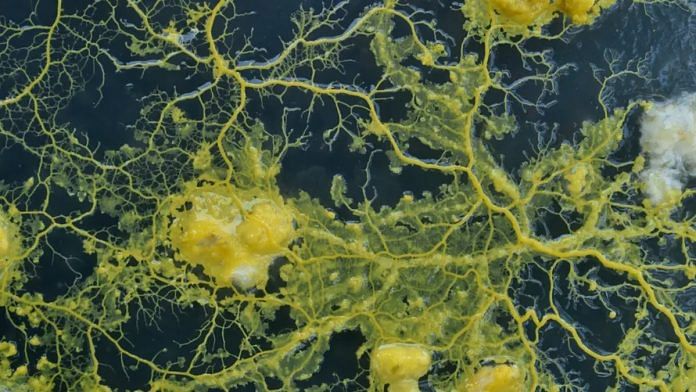Bengaluru: An intelligent, brainless organism nicknamed ‘The Blob’, after the 1958 eponymous movie villain, is on display at a Paris zoo. The species has been around for as many as a billion years, but caught the world’s attention when it was put on display last weekend at the Paris Zoological Park.
Physarum polycephalum, Latin for “many-headed slime” and the biological name for The Blob, is neither an animal nor a plant. It is classified as a type of mould, and was thought to be a fungus for a very long time.
Scientists now believe it is a kind of amoeba. An entire slime mould is just one cell with hundreds of thousands of nuclei. It spreads around and grows rapidly, extending its tentacle like limbs, called pseudopodia, reaching movement speeds of up to 4 cm an hour.
Despite having no mouth or stomach, this yellow-coloured Blob can gorge on food. One of its favourites is apparently oats. It also doesn’t have a brain or a nervous system.
It is not capable of long-term memory storage, learning and acquiring knowledge, or skilled decision-making. But it can still construct transport networks and find its way around and through a maze.
When oats are placed at two points of a maze where The Blob is grown, it finds the shortest path from which it can grow to connect to both food sources, thus solving the shortest path problem. If more food sources are added, it also solves a more complicated transportation problem by optimising growth. It forms efficient networks connecting food sources to distribute nutrients throughout its body.
Also read: A historic all-women spacewalk outside International Space Station, finally
The Blob’s balanced diet
The Blob also displays a form of primitive memory. Researchers have performed a Pavlovian conditioning on the mould. They repeatedly made the test environment extremely cold and dry for it after every 60 minutes and observed later that the mould remembered and anticipated this pattern every 60 minutes, and produced the same physiological reaction even when there was no temperature change.
Researchers were also able to make the slime mould learn to enter rooms that it would normally avoid due to presence of toxic substances.
The Blob also intelligently consumes a balanced diet and optimises its nutrition intake. Over its network, studies have shown, The Blob can absorb the precise quantity of food in exact proportions for a nutritious diet of required carbohydrates and proteins, maintaining a balance of carbon and nitrogen based nutrients.
Unlike humans and most creatures whose biological sex is binary, The Blob actually has 720 sexes. The Blob reproduces by releasing spores, which eventually develop into sex-determining cells. For successful reproduction to occur, two spores of different sexes should come into contact. To maximise its chances, this slimy ameboid has also learnt to produce gene variants for 720 sexes.
If The Blob is cut into two, it can regenerate itself rapidly, in under two minutes. In fact, The Blob doesn’t age and die at all, it can remain immortal unless exposed to too much light or starved. It can fuse into one if brought in contact with tube-like structures connecting the two cells’ cytoplasm, joining to become a single cell.
The creature can help us learn how to optimise our mathematical problems and design faster computers by testing new solutions and speed of responses to visual stimuli.
Also read: ISRO releases first illuminated images of moon taken by Chandrayaan-2’s orbiter



